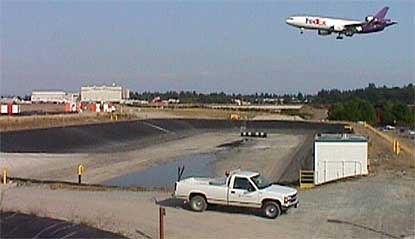Port of Seattle's IWS experience offers valuable lessons

To help preserve the environment of the community it serves, the Port of Seattle developed an extensive program to protect waters near its facilities.
The industrial waste system (IWS) at the Sea-Tac Airport has provided the Port with cost and environmental protection advantages for almost 40 years.
Now, the Port is upgrading the system to meet all local, state, and federal airport and environmental standards regarding disposal of gas, oil, and—especially—glycol.
How IWS Works
The IWS gathers water from 365 acres of impervious surface areas, including terminals and maintenance yards that are likely to contain such contaminants as de-icing fluid (glycol), fuel, and oil. Because the airport separates its industrial wastewater from its storm water, it will have much less water to send for biological treatment.
The system comprises 22 miles of drains that flow to lagoons that hold the water until it can be treated at the adjacent wastewater treatment plant. Lagoons One and Two (and soon to be Three) are lined with 100-mm-thick high-density polyethylene liners.

Once in the plant, the water is screened for large debris, including everything from luggage tags and food containers to the orange wands used by ground crews to guide planes. The water is then treated through a dissolved air flotation (DAF) process. The DAF process goes one step beyond typical oil and water separation (which only removes free product) by actually breaking the emulsion of the oil, resulting in a float of oil and solids. This float is removed and placed in tanks on site for further settling.
Ten employees maintain the wastewater treatment plant in shifts around-the-clock during the rainy season and in two shifts during the dry season. All plant employees have been certified as State of Washington Operators-in-Training for Wastewater Treatment Plants.
The treated wastewater gravity-flows through a pipe to a deepwater outfall in Puget Sound. After the waste in the storage tanks has settled, the tanks are dewatered, and a private contractor disposes of the remaining waste.
Current Upgrade to the IWS
The Port has completed approximately U.S.$12 million in capital improvements to the IWS in the past four years. The current phase includes a $19-million expansion of the third industrial wastewater storage lagoon.
Based on runoff projections for the next 20 years, in combination with anticipated development, engineers have estimated a lagoon expansion to at least 47-million gallons from its existing 26-mil-gal capacity. However, the Port of Seattle has decided to go beyond this minimum requirement and is upgrading the lagoon to a capacity of 72 million gallons.
At its expanded size the lagoon, which situates to the south of the treatment plant on a site that is approximately 22 acres, will measure 950 ft by 350 ft.
A challenge the engineers face in expanding the lagoons is the presence of several freshwater springs located directly in the area where the lagoon will be expanded, since rising spring water could cause the liner of the lagoon to float. To address this possibility, the engineers designed a groundwater collection system that will be installed beneath the lagoon liner. The system will empty into the Port's storm-water system without treatment, since the water in this drainage system will not be in contact with the water in the lagoon.
The previous case study was adapted from the feature "Saving money and the environment: How one airport manages storm water and industrial wastewater," which posted to Water Online, a companion site to Pollution Online within the VerticalNet e-commerce family. The original feature was authored By Teresa Foster Eckard, Aviation Project Manager, Port of Seattle. Eckard is a registered professional engineer.
Contact: Teresa Foster Eckard P.E., Aviation Project Manager, Port of Seattle. Tel: 206-248-7130.
